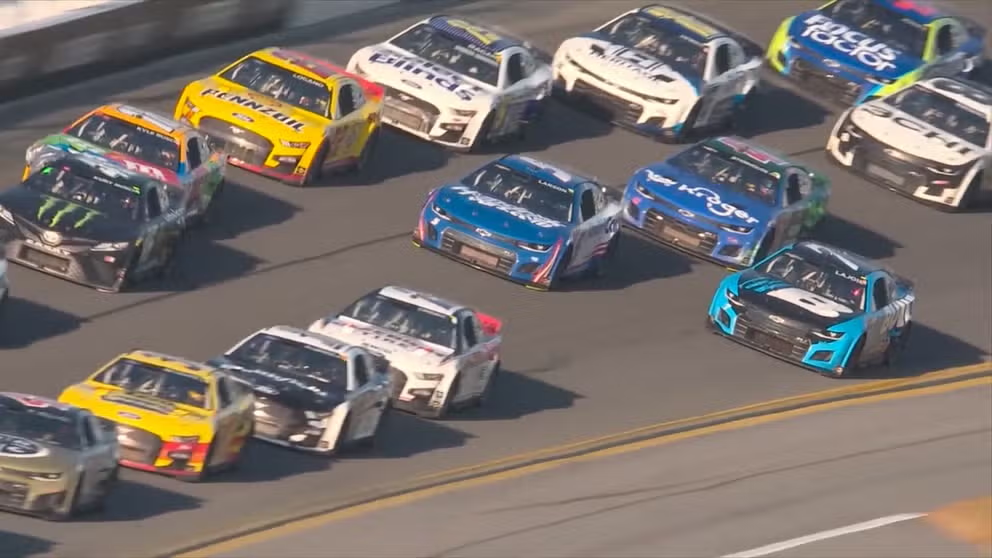Keeping NASCAR drivers from overheating is a balance of aerodynamics and safety
Race car drivers prepare to sweat pounds on race day through endurance training and staying (really) hydrated.
How the weather plays a big role on NASCAR race day
To cross the finish line first, drivers must navigate the weather conditions as expertly as they do the competition.
DAYTONA INTERNATIONAL SPEEDWAY, Fla. – NASCAR drivers have no air conditioning and spend hours on a hot racetrack behind a burning engine. Keeping race car drivers cool isn’t an option, but making sure they don’t overheat and consume enough calories is as close as they’ll get if they want to win the championship.
Landon Cassill drives the No. 10 car for Kaulig Racing in the Xfinity Series. He spoke to FOX Weather from the Daytona International Speedway ahead of the 300-mile-long race in 2022.
The Chevy Camaro he drives is built for speed and does not have a lot of "creature comforts" that come with a daily driver, like air conditioning.
"It does have a big old heater, and that's the engine that sits in front of me," Cassill said. "It's a race car that's meant to go fast and to keep you safe."
FROM IN-CAR TEMPERATURES AS HIGH AS THE 130S TO RAIN, HOW WEATHER IMPACTS NASCAR RACES
The whole car produces a lot of heat from the engine, breaks and drive line, but the inside of the vehicle can get anywhere between 100 degrees to 140 degrees Fahrenheit.
"Some of the races that we run in the summertime are hot weather climates as well. We've been in Las Vegas and raced in 107-degree weather. You know, Texas, it gets really hot when we race there. If it's north of 85 degrees outside, the inside of the car will get to be about 140."
When it’s that hot inside a car with no air conditioning and every pound you add to the car matters, teams like Kaulig Racing have other means to keep their drivers from overheating and getting dehydrated.
Cassill said the first step is to be physically fit. Endurance training similar to marathon runners or cyclists is also beneficial for race car drivers. Additionally, good nutrition is a big part of any race car driver's daily life.
Drivers wear jumpsuits made of fire-retardant materials. While those are critical to their safety, Cassill said a head-to-toe jumpsuit doesn’t make you any cooler.
The racing suits used by Kaulig made by Sparco are designed to be lightweight, and Cassill said they're breathable enough, so sweat isn’t just clinging to the driver.

File photo: Landon Cassill (#77 Spire Motorsports Mutoh/General Formulations Chevrolet) fist bumps fans before the NASCAR Cup Series Championship Race on November 6, 2022 at Phoenix Raceway in Avondale, Arizona. (Photo by Kevin Abele/Icon Sportswire via Getty Images)
(Getty Images)
Speaking of sweat, the next important step is staying hydrated.
NASCAR USES SPECIALTY TRACK-DRYING TECHNOLOGY TO RID THE RAIN FROM RACETRACKS
While he’s on the track, Cassill said he takes in calories while driving. He drinks about 20 to 40 ounces of fluid per hour, depending on how hot it is in the car.
"In that drink mix is about 300 calories, so I'm taking in about 300 calories per hour in the car."
Even after drinking hundreds of calories per hour, race car drivers will still sweat more water than they can consume.
"I've weighed myself before and after races before, and probably the most extreme scenario that I've ever seen was a race where I lost 8 pounds total net from before the race, to after the race, and that with 120 ounces of water that I drank during the race."
Cassill drank about 1 gallon of water, consuming calories in each sip, and still lost 8 pounds.
A driver's helmet also helps keep his head safe and somewhat cool. It has a hose attached to the back that works as a carbon monoxide filter, and it blows air into the helmet.
For really hot races, drivers can wear a cool shirt.
LIGHTER THAN AIR: PILOTING THE GOODYEAR BLIMP
"It's a shirt that has piping through it and runs kind of a circulated fluid through it that can help lower your body temperature a little bit," Cassill said. "You definitely don't ever feel cool in the car by any means unless it's 50, 60 degrees outside. But it does help manage your body temperature."
The driver’s seat also has a hole in the back where the team can mount a cooling tube to blow into the back of the chair onto the driver’s back.
There is the option to run a hose off the side of the car that will pull air from outside the vehicle and direct it to the driver, but sometimes those can be performance inhibitors messing with the car's aerodynamics.
"We don't like to open those up as very often. So the teams will try to close those as much as they can," he said. "Drivers usually have to just deal with what they got."
On race day, Cassill said his ideal forecast includes sunshine and a high of 70 degrees.
